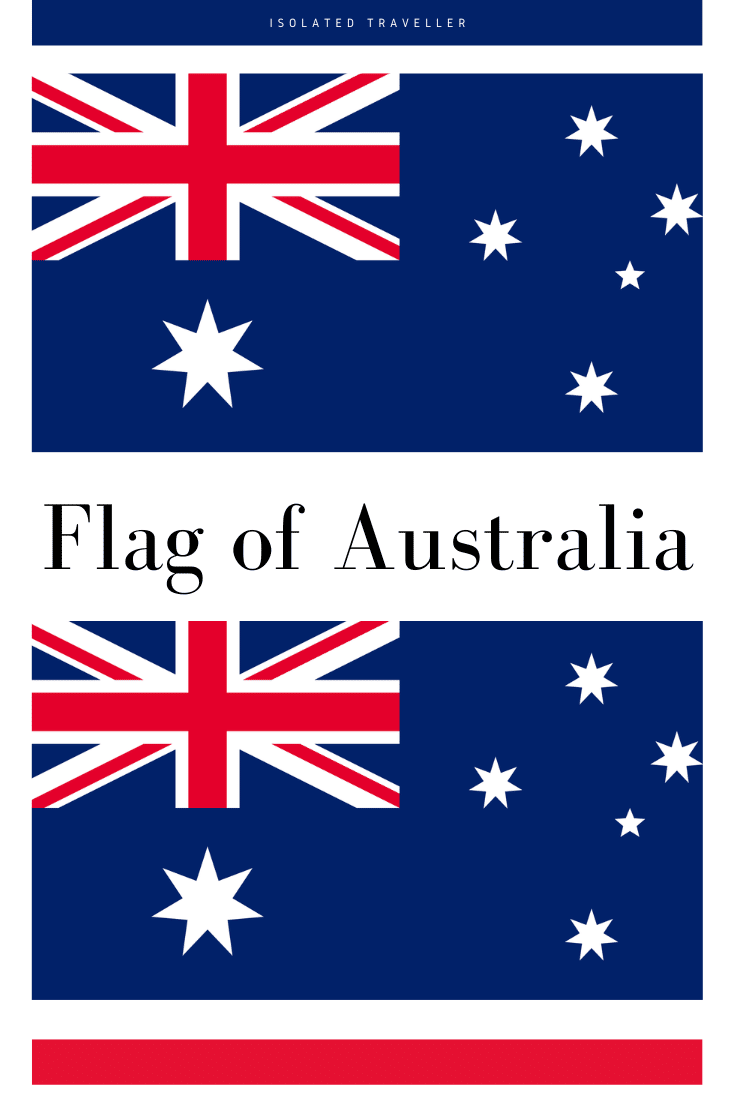The flag of Australia is a defaced Blue Ensign: a blue field with the Union Jack in the canton, and a large white seven-pointed star known as the Commonwealth Star in the lower hoist quarter. The fly contains a representation of the Southern Cross constellation, made up of five white stars – one small five-pointed star and four, larger, seven-pointed stars. There are other official flags representing Australia, its people and core functions of government.
Flag of Australia
The flag of Australia is a blue background with the Union Jack in the upper left corner. There are five white stars on the right side, and a large seven-pointed star in the lower-left corner. The flag is made up of two horizontal bands of blue; one-quarter of the width of that band is white.

Symbolism
The Australian flag is on a blue background with the Union Jack in the top left corner. The Union Jack is a symbol of Australia’s history as a former British colony, and it has seven points on it, representing the six states and territories of Australia. The Southern Cross is also on this flag; it’s a constellation that can be seen from any point in Australia.
Design
The flag of Australia consists of a defaced Blue Ensign. In Australian vexillology, the term “Blue Ensign” refers to an official flag used by government and civil ships as well as any organization that wishes to use their own flag but not create a new one.
Australia’s ensign was officially adopted on 4 September 1901, but it had been in use since colonial times. It has been used continuously in Australia since then except for 1901-1902 when New South Wales and Victoria temporarily used their own flags while they were separate colonies of Great Britain.
History
The Australian flag is a symbol of Australia’s multiculturalism, democracy, and national identity. It was designed by a schoolgirl named Louise Darvall in 1901—and no one quite knows why she chose what she did.
Flag Day
On 26 January each year, we celebrate Australia Day to commemorate the adoption of our flag. The flag is a symbol of unity and identity, as well as an important part of our values and principles. In many ways, it represents who we are as Australians.
In 1901 when the federation took place, New South Wales had already adopted its own flag while other states were still using British or colonial flags. At this time, no one thought it was necessary for all Australian states to have their own flag because they were part of one nation: Australia! However, in 1908 at the request of Colonel Ralph Henderson – who was part of an organisation called The League for National Unity, several prominent citizens decided that each state should have its own unique banner in order to make clear its independence from Great Britain. They then designed some new designs based upon ideas suggested by local people across Australia during a competition organised by The Bulletin magazine; these included suggestions such as incorporating strange creatures into their design such as kangaroos or emus, seals or koalas.
The winning design came from Sir William Dargie who drew inspiration from England’s Tudor Rose combined with wattle flowers native to New South Wales – this meant that he combined two different symbols together which would eventually form our modern-day national emblem today: red background with a white circle containing five wattle flowers pointing upwards toward the centre point where there exists another blue disc with the sun shining down upon them all (representing daylight breaking through clouds).”
Conclusion
It’s worth noting that the Australian flag is probably one of the most recognisable national flags in the world – this goes a long way towards explaining why it has become such an important symbol for Australians. It also highlights how much we value our national identity, even if this isn’t always obvious from day to day.


